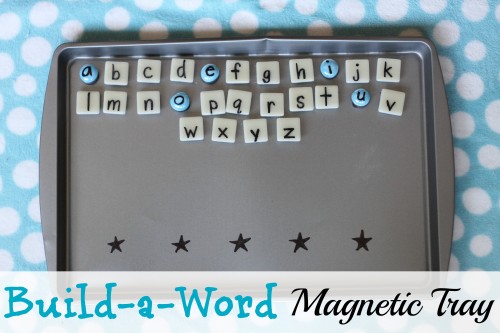 The ladies over at Freebielicious are hosting a great book study Check out the blogs linked up on Marsha's blog A Differentiated Kindergarten. Lots of examples and freebies.
The ladies over at Freebielicious are hosting a great book study Check out the blogs linked up on Marsha's blog A Differentiated Kindergarten. Lots of examples and freebies. To go with the book study, I was also checking out Jan Richardson's website and found a clip where she writes the letters on the cookie sheets for magnetic letters in making words activities. How much sense does that make sense for passing out materials but also for letter id. On the Maggie's Kinder Corner facebook page, she shared a link and this picture
 to build-a-word magnetic tray. The author Jenae used tiles and gems to write the letters on. Again, I'm thinking I will be wishing for some magnetic trays to start the year off.
to build-a-word magnetic tray. The author Jenae used tiles and gems to write the letters on. Again, I'm thinking I will be wishing for some magnetic trays to start the year off.  Another great beginning alphabet small group (or if you are lucky assistant/volunteer activity) is to use tongs or tweezers like these tongs from Montessori Services. I have a variety of tong types from the kitchen section of the dollar store. You can use any type of letter tiles. I have foam tiles in both thick and thin to work those fine motor skills. The students are activating different parts of their brain in this tactile activity. You can work with the letters in their names in this activity. Each child gets a name plate. They take turns using tongs to select a letter tile (hide them in a small container of rice or lay them out on the table depending on your kids) and identify the letter. If it fits in their name, they get to place it over that letter on their name plate. You can do the same with the letter arcs or letter charts. All of these can be used to work on letter name or letter sound identification. You may want to alternate using arc and a letter chart with picture cues.
Another great beginning alphabet small group (or if you are lucky assistant/volunteer activity) is to use tongs or tweezers like these tongs from Montessori Services. I have a variety of tong types from the kitchen section of the dollar store. You can use any type of letter tiles. I have foam tiles in both thick and thin to work those fine motor skills. The students are activating different parts of their brain in this tactile activity. You can work with the letters in their names in this activity. Each child gets a name plate. They take turns using tongs to select a letter tile (hide them in a small container of rice or lay them out on the table depending on your kids) and identify the letter. If it fits in their name, they get to place it over that letter on their name plate. You can do the same with the letter arcs or letter charts. All of these can be used to work on letter name or letter sound identification. You may want to alternate using arc and a letter chart with picture cues. Picture Copyright © William Vicars, sign language resources at Lifeprint.com" I also like to teach the sign and a motion for the letters. Checkout these from lifeprint. When the year gets further along and we are working hard to identify short u in words, the sign for up shows up. Heidi's Songs' Action Alphabet (youtube here) song is great. We use it whole group and refer to it in small group.
Now a little on working with sounds...I am all about phonemic awareness. Are these sounds the same or different? Which of these 3 sounds different? Do these two words rhyme? Which of these 3 rhyme? I teach and assess both orally and with pictures. We will do hand signals in front of our chests, use craft sticks with happy bear/sad bear on opposite sides, and even big gestures (like from Jack Hartmann's Make a Rhyme, Make a Move. I just made a set of cards to play rhyming memory using scalloped frames. Each short vowel has 4 matches (8 cards) and is in a different color for easy sorting with a mixed set. You can expand the memory game by mixing sets. There are 2 styles - background and no background (to save ink or for cutting around the scallops).
Memory of any kind is a favorite game of my kinders. You can also use the cards to lay out three and have them pick the two that rhyme. Another version to engage a small group is to give each player 3 cards face up in front of themselves and put the matching cards upside down like you would for memory. The players take turns turning over one card looking for a match to one of their 3 cards.
Thanks for making it through my post. I'd love some comments on activities you use or topics you are interested in.
Jenn
Don't Forget....Check out the last post for more info.
a Rafflecopter giveaway


Those video clips from Jan Richardson's website are great -- thank you for sharing!
ReplyDelete